You might think maintaining your cruiser is too time-consuming, but it doesn't have to be. Simple, regular tasks can greatly enhance your bike's performance and longevity, guaranteeing a smoother ride and fewer unexpected repairs. From oil changes to tire checks, each maintenance step plays an essential role in keeping your cruiser in top shape. Are you aware of the vital practices that can save you both time and money while enhancing your riding experience? Let's explore some effective tips to make certain your cruiser stays reliable and enjoyable.
Quick Takeaways
- Perform regular oil changes every 3,000 to 5,000 miles to maintain engine efficiency and prolong lifespan.
- Check tire pressure and tread depth frequently to ensure safe and optimal performance.
- Inspect and maintain brake pads and fluid levels to ensure effective braking and safety.
- Regularly clean and lubricate the chain, and check sprocket wear for smooth operation.
Regular Oil Changes
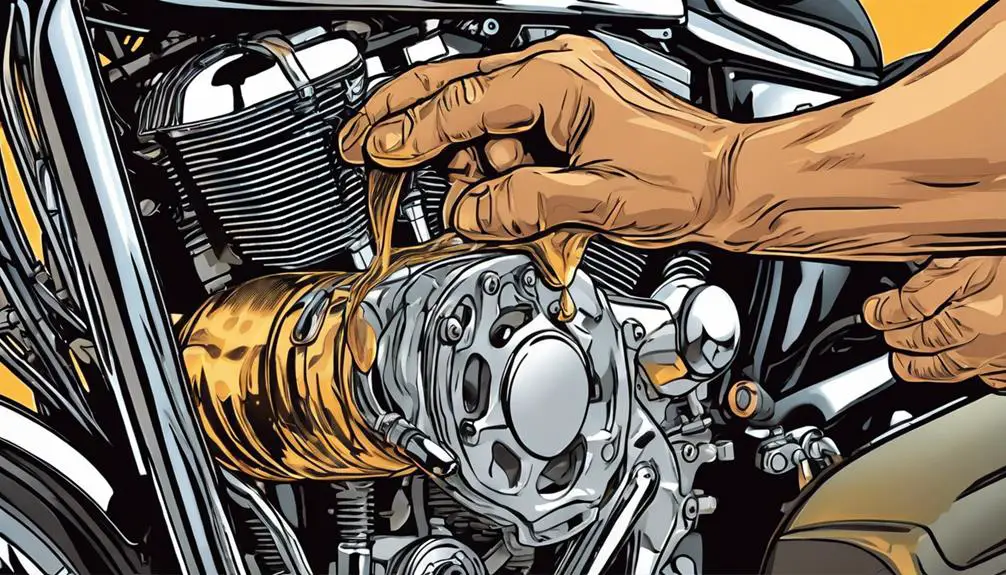
Regular oil changes are vital for keeping your cruiser's engine running smoothly and efficiently. You don't want to feel the weight of the world on your shoulders when your ride starts sputtering or, worse, breaks down.
By changing the oil regularly, you guarantee that your engine's moving parts remain lubricated, reducing friction and preventing wear. This simple act can liberate you from costly repairs and give you peace of mind while you explore the open road.
When you change your oil, you're also removing impurities and contaminants that accumulate over time. Think of it as cleansing your cruiser, letting it breathe freely and perform at its peak.
You should check your oil level regularly and follow the manufacturer's recommendations for change intervals, usually every 3,000 to 5,000 miles or as indicated by your oil life monitor.
Investing time in this vital maintenance task protects your engine and enhances its performance, allowing you to enjoy the freedom of the ride with confidence.
Tire Maintenance Practices
Maintaining proper tire pressure and tread depth is just as important as keeping your engine oil fresh, guaranteeing a safe and smooth ride on your cruiser. You want to feel the freedom of the open road without worrying about your tires.
Here are some essential tire maintenance practices to keep your ride liberating:
- Check Tire Pressure Regularly: Use a reliable gauge to verify your tires are inflated to the manufacturer's recommended levels.
- Inspect Tread Depth: Use the penny test—insert a penny into the tread; if you see Lincoln's head, it's time for new tires.
- Rotate Tires: Change the position of your tires every 5,000 to 7,500 miles to promote even wear.
- Look for Damage: Regularly inspect for cuts, punctures, or blisters that could compromise safety.
Brake System Inspections
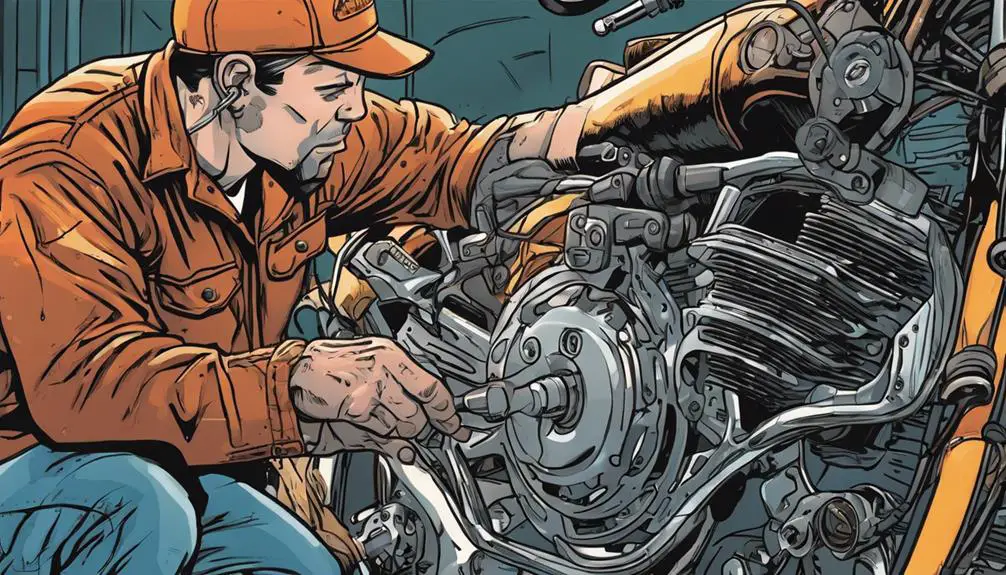
When it comes to your cruiser, keeping the brake system in top shape is essential for safety.
You should inspect brake pads regularly, check brake fluid levels, and test brake performance consistently.
Staying on top of these tasks can help prevent issues and guarantee a smooth ride.
Inspect Brake Pads Regularly
Inspecting your brake pads frequently guarantees that your cruiser remains safe and responsive on the road.
It's not just about performance; it's about your freedom to ride without worry. Neglecting your brakes can lead to dangerous situations, so make it a habit to check them regularly.
Here's what to look for when you inspect your brake pads:
- Thickness: Verify they're not worn down to the metal.
- Cracks or chips: Look for visible damage that could compromise performance.
- Uneven wear: Check if one pad is more worn than the others, which might indicate alignment issues.
- Squeaking or grinding noises: If you hear anything unusual while braking, it's time to investigate.
Check Brake Fluid Levels
After checking your brake pads, it's time to verify your brake fluid levels are up to par for peak performance. Brake fluid is crucial for your system's efficiency, acting as the lifeblood that transfers force from your foot on the pedal to the brakes themselves. Low fluid levels can lead to compromised braking power, which isn't what you want when you're cruising freely down the open road.
To check the fluid, locate the reservoir—usually found near the back of the engine bay. Make certain the level sits between the 'min' and 'max' marks. If it's low, top it off with the appropriate brake fluid specified in your vehicle's manual. Be wary of contamination; don't let dirt or moisture into the reservoir, as that can lead to costly repairs down the line.
If you notice a significant drop in fluid levels frequently, it might indicate a leak in the system. Addressing this issue promptly guarantees you maintain your freedom on the road without worrying about brake failure.
Regularly checking your brake fluid levels is a simple yet crucial step in keeping your cruising experience smooth and liberating.
Test Brake Performance Consistently
Regularly testing your brake performance guarantees your system remains responsive and reliable on every ride. You wouldn't want to compromise your freedom on the open road, so make this a routine part of your maintenance.
Here are some essential steps to maintain your brake system:
- Check Brake Pads: Look for wear and replace them if they're thin.
- Test Stopping Power: Find a safe, open area to assess how quickly you can stop.
- Inspect Brake Lines: Examine for leaks or cracks that could hinder performance.
- Listen for Unusual Noises: Pay attention to any grinding or squeaking sounds when braking.
Chain and Sprocket Care
Keeping your chain and sprockets in top shape is essential for a smooth ride and extended bike life. Neglecting them can lead to poor performance and costly replacements.
Start by regularly cleaning your chain using a degreaser. This removes the grime that builds up and can wear down your components. After cleaning, make sure to lubricate the chain with a quality motorcycle chain lube. A well-lubricated chain operates smoothly and reduces friction, giving you the freedom to roam without worry.
Next, inspect your sprockets for wear. Look for hooked or worn teeth, which can signal it's time for replacements. You don't want to risk a breakdown on the open road.
Additionally, check your chain tension regularly; it should have a slight slack, allowing for movement without excess play. Adjust it according to your bike's specifications to maintain peak performance.
Electrical System Checkups
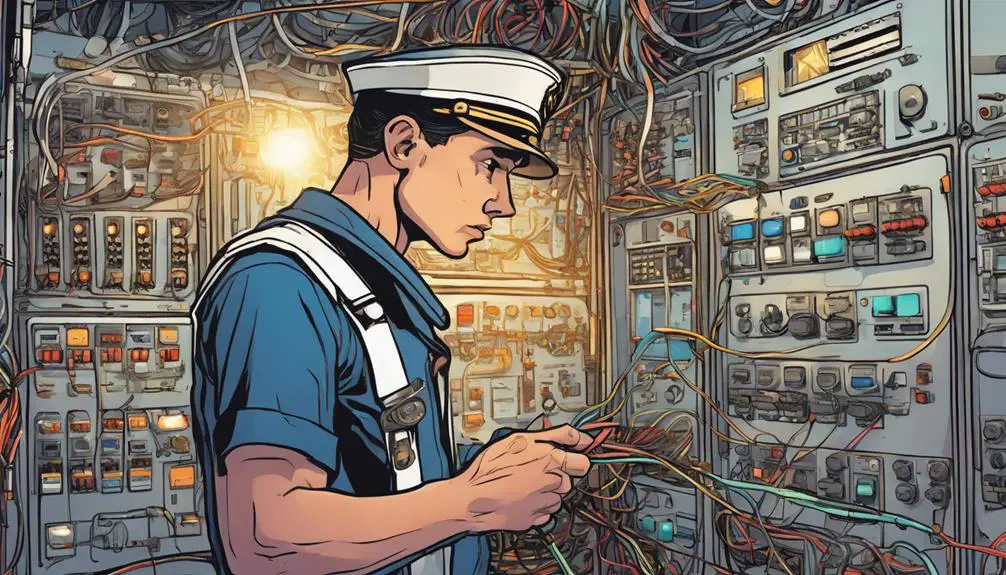
Keeping your cruiser's electrical system in top shape is essential for smooth sailing.
Start with regular battery inspections to verify it's holding a charge.
Then check the wiring for any signs of wear or damage.
Regular Battery Inspections
Performing routine battery inspections is essential to guaranteeing your cruiser's electrical system runs smoothly and reliably. A well-maintained battery not only keeps your adventures powered but also prevents those frustrating moments when you're stuck with a dead battery.
Here are some tips to keep your battery in top shape:
- Check the terminals: Confirm they're clean and free of corrosion, as this can hinder performance.
- Inspect the water level: If you have a flooded lead-acid battery, make sure the water covers the plates.
- Test the charge: Use a multimeter to check voltage levels; a healthy battery should read around 12.6 volts or more.
- Look for leaks: Any signs of electrolyte leakage can indicate a problem that needs immediate attention.
Wiring Integrity Assessment
Regularly evaluating your wiring's integrity is crucial for preventing electrical failures and ensuring a safe cruising experience. Start by inspecting visible wires for any signs of wear, fraying, or corrosion. If you spot any damage, replace those wires immediately. Pay particular attention to connections; loose or corroded terminals can cause issues that lead to bigger problems down the line.
Next, check the insulation on your wiring. It should be intact and free from cracks or abrasions. Damaged insulation can expose wires and create hazardous situations. Consider using a multimeter to test for continuity across your circuits, ensuring that electricity flows smoothly and without interruptions.
Don't forget to assess the grounding system. A solid ground connection is essential for safety and performance. Make sure it's clean and securely fastened.
Circuit Breaker Functionality
Evaluating your circuit breaker functionality is just as important as checking your wiring, as it plays a key role in protecting your electrical system from overloads and short circuits. A well-functioning circuit breaker guarantees you can explore freely without the nagging worry of electrical failures.
Here's how to keep your circuit breakers in top shape:
- Test the Breakers Regularly: Flip the switches every few months to verify they're operational.
- Inspect for Signs of Wear: Look for discoloration or burning marks that could indicate a problem.
- Check the Ratings: Verify each breaker is appropriately rated for the appliances it protects.
- Clean the Panel: Dust and moisture can hinder performance, so keep the circuit breaker panel clean and dry.
Taking these steps will empower you to maintain a safe cruising experience. After all, when you're out on the open water, the last thing you want is an electrical hiccup holding you back!
Fluid Level Monitoring
Monitoring fluid levels is vital to keep your cruiser running smoothly and prevent costly repairs. Regularly checking engine oil, coolant, brake fluid, and transmission fluid guarantees that everything's in tip-top shape, allowing you to embrace the open waters without worry. When you neglect these checks, you're risking not only your cruiser's performance but also your freedom on the water.
Start by inspecting your engine oil at least once a week. Pull out the dipstick, wipe it clean, then reinsert it to get an accurate reading. For coolant, verify it's at the recommended level; overheating can lead to serious damage.
Brake fluid is critical for safety, so don't overlook it—check regularly to make sure it's within the safe range. Don't forget about transmission fluid, either. A simple dipstick check can save you from future headaches.
When you keep a close eye on these fluids, you empower yourself to tackle the open sea without hesitation. So grab that dipstick, take charge of your maintenance, and enjoy the exhilarating freedom that comes with knowing your cruiser is ready for anything!
Routine Filter Replacements
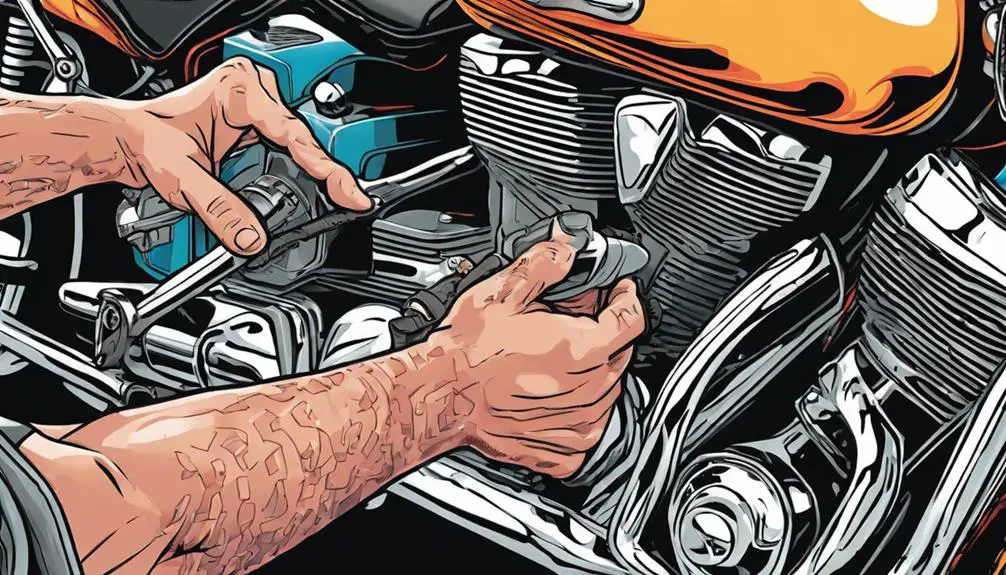
Keeping your cruiser's filters fresh is essential for ideal performance and longevity. Regular filter replacements guarantee your engine runs smoothly and efficiently, freeing you to enjoy the open water without worries.
You mightn't think about filters often, but neglecting them can lead to serious issues down the line. Here's how to keep things flowing:
- Oil Filter: Change it with every oil change to keep your engine lubricated and clean.
- Fuel Filter: Replace it regularly to prevent contaminants from damaging your fuel system.
- Air Filter: Check it for dirt and debris, and swap it out if it looks clogged, allowing your engine to breathe.
- Transmission Filter: Don't overlook this one; replace it based on your transmission fluid change schedule.
Cleaning and Detailing Tips
To maintain your cruiser's appearance and protect its surfaces, regular cleaning and detailing are essential. Start by washing your cruiser with a mild soap specifically designed for vehicles. This prevents scratches and preserves the paint. Use a soft sponge or microfiber cloth to gently scrub away dirt and grime, ensuring you reach every nook and cranny.
Don't forget the wheels! A dedicated wheel cleaner can help remove brake dust and road grime, leaving them sparkling. After washing, dry your cruiser thoroughly to prevent water spots. A quick wax or sealant application can provide an extra layer of protection and enhance shine.
For detailing, invest in quality products. Use a clay bar to remove contaminants that washing alone can't eliminate. Follow up with polish to restore any dullness, then apply a protective coating.
Inside, vacuum the upholstery and use a mild cleaner for surfaces. Protect your dashboard and other plastic parts with UV protectant to prevent fading.
Regularly cleaning and detailing your cruiser not only keeps it looking great but also enhances your freedom on the open road, allowing you to enjoy the journey to the fullest.
Suspension System Maintenance
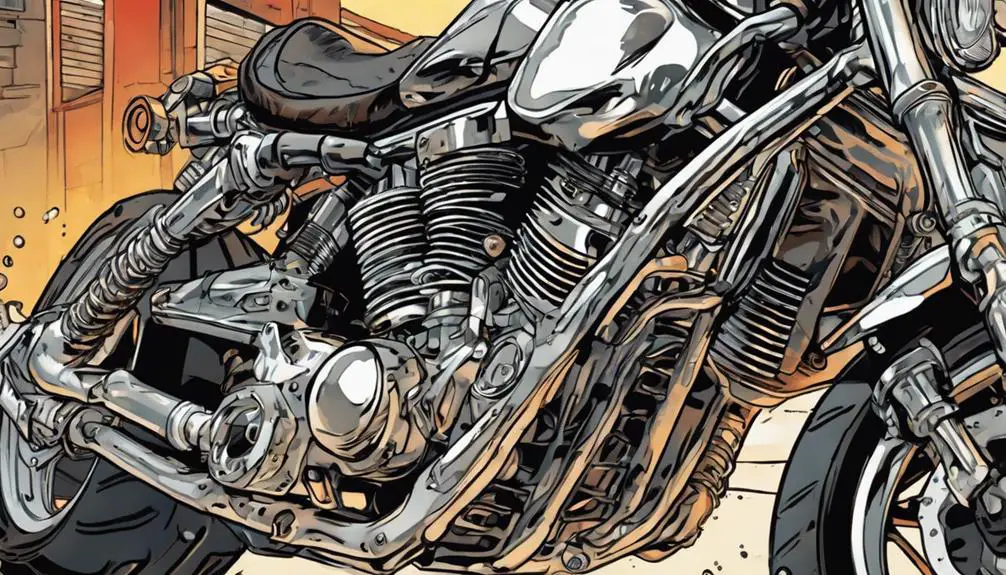
When it comes to your cruiser's ride quality, the suspension system plays an essential role.
You should inspect shock absorbers regularly to guarantee they're functioning properly, and adjusting the spring preload correctly can make a significant difference in handling.
Taking these steps will keep your ride smooth and enjoyable on the road.
Inspect Shock Absorbers Regularly
Regularly inspecting your shock absorbers is essential for maintaining a smooth and safe ride on your cruiser. These components play a crucial role in your suspension system, absorbing bumps and ensuring your tires stay in contact with the road. Neglecting them can lead to a rough ride and compromised safety.
Here's what you should look for during your inspections:
- Leaking Fluid: Check for oil leaks around the seals. If you see any, it's time for replacement.
- Dents or Damage: Inspect the shock body for any dents or visible damage that could affect performance.
- Unusual Noises: Listen for clunking or knocking sounds while riding. These can indicate worn-out shocks.
- Bounce Test: Push down on your cruiser; if it bounces more than once, your shocks might be shot.
Adjust Spring Preload Correctly
Adjusting the spring preload on your cruiser is essential for achieving ideal handling and ride comfort. This simple adjustment can transform your ride, allowing you to tackle any road with confidence and freedom.
Start by measuring the sag, which is the distance the suspension compresses under your weight. You want about an inch or two of sag when you sit on the bike.
To adjust, locate the preload adjustment ring on your shock. If it's too stiff, you may feel every bump, while too soft can lead to bottoming out. Turn the ring clockwise to increase preload, making the ride firmer; turn it counterclockwise to soften it.
Once you make adjustments, take your cruiser for a spin. Pay attention to how it handles in corners and over bumps. You should feel balanced and in control.
Seasonal Storage Guidelines
Properly preparing your cruiser for seasonal storage can prevent damage and guarantee it's ready for your next adventure. Follow these essential guidelines to make certain your beloved vessel stays in top shape while it's parked for the season:
- Clean and dry: Wash the exterior and interior thoroughly, removing salt, dirt, and mold. Make sure everything is completely dry to avoid moisture buildup.
- Empty the tanks: Drain fuel and water tanks to prevent contamination and freezing. Consider adding a fuel stabilizer for that extra layer of protection.
- Protect the engine: Change the oil and filter, then run the engine briefly to circulate the new oil. This step reduces corrosion.
- Cover it up: Invest in a quality cover that fits your cruiser snugly to protect it from dust, pests, and UV rays.
Common Questions
How Often Should I Check My Battery Connections?
You should check your battery connections regularly to guarantee everything's running smoothly. Ideally, do it at least once a month.
If you're heading out for a long trip, give them a thorough inspection beforehand. Loose or corroded connections can lead to power loss, so be proactive.
Keeping your battery in top shape empowers you to explore and enjoy your freedom on the open road or water without unnecessary interruptions.
Stay vigilant!
What Are Signs of Wear in My Cruiser's Seat?
When you're checking your cruiser's seat for signs of wear, look for cracks, tears, or faded upholstery.
Pay attention to any sagging or loss of padding, which can affect comfort during your adventures.
If you notice the stitching coming undone or fraying edges, it's time to take action.
Regularly inspecting these details not only enhances your ride but also keeps your spirit of freedom alive and well on the open water.
How Can I Improve My Cruiser's Fuel Efficiency?
To improve your cruiser's fuel efficiency, check your tire pressure regularly; under-inflated tires can waste fuel.
Keep your engine well-tuned, as a properly maintained engine runs more efficiently.
Reduce weight by removing unnecessary gear, and try to maintain a steady speed instead of rapid acceleration and braking.
Use the highest gear possible without straining the engine, and consider cruising at a moderate speed; it can make a notable difference in your fuel consumption.
What Tools Are Essential for Basic Cruiser Maintenance?
So, you think cruising's all about lounging with a drink in hand? Think again!
For basic maintenance, you'll need a few tools to avoid turning your freedom ride into a floating disaster.
Grab a good socket set, a sturdy screwdriver, and a trusty wrench. Don't forget a multimeter for electrical checks and a basic toolkit for emergencies.
Keep these handy, and you'll enjoy the open waters without the stress of unexpected breakdowns!
How Do I Know When to Replace My Spark Plugs?
You'll know it's time to replace your spark plugs when you notice engine misfires, rough idling, or decreased fuel efficiency.
If your engine struggles to start or you see a drop in power, that's another sign.
Keep an eye on your mileage; typically, spark plugs should be replaced every 30,000 to 100,000 miles, depending on the type.
Regular checks can help you maintain your vehicle's performance and keep your ride liberating.
Wrapping Up
Just like a ship needs a sturdy anchor to weather the storms, your cruiser thrives on diligent maintenance.
By keeping up with oil changes, tire checks, and brake inspections, you guarantee a smooth voyage through the open road.
Regular care is your compass, guiding you away from costly repairs and toward adventures ahead.
So, treat your cruiser like the treasure it is—polish it, protect it, and it'll navigate the journey with you for years to come.